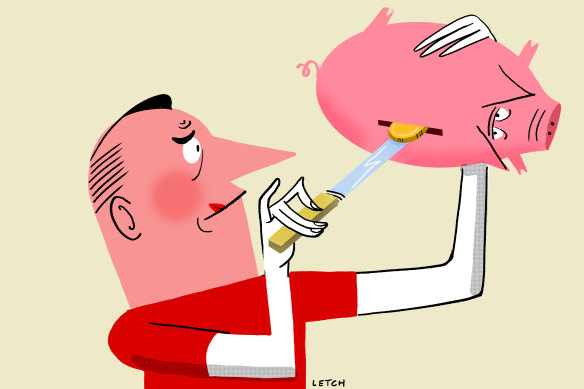
Oh, 2017. What a lifetime ago those simpler times feel like. Sophie Monk searched for love on The Bachelorette. Amazon launched Down Under. Donald Trump gave us the term “covfefe”, and Schapelle Corby finally returned to Australia as a free woman 13 years after being arrested in Bali.
I enjoy a walk down memory lane as much as the next person, but the reason for reminiscing on the good old days of life with an iPhone 8 isn’t actually all that good this week. In fact, it’s pretty bloody bad, especially if you’re one of the millions of Australians who are, at best, feeling the economic pinch and, at worst, scraping through our current cost of living hellscape by the skin of your teeth. And that’s because, according to new data from the Organisation for Economic Co-operation and Development, Australians are living and spending like it’s 2017.

Millions of Australians are feeling the economic pinch.Credit: Simon Letch
Released last week, the OECD data found that when compared with 19 other member nations’ economies, Australian households experienced the largest drop in inflation-adjusted disposable income over a two-year period to March 2024.
And, deep breath in here, so great is the dip in our purchasing power that economists are warning it will take a further two years to even recover to pre-pandemic levels, let alone return to financially living as if we’re in this decade. Yep, that’s the promise – or threat, depending on how you see it – of living in 2026 on a 2020 budget.
Australia wasn’t the only country to go backwards during the same two-year period. However, what’s so scary are both the size of the drop, and what it means when compared with other OECD incomes.
Disposable incomes of people living in Czechia, Denmark, Sweden and Canada also all went backwards during the same period, but Australian incomes are higher than in those nations. By OECD standards, Australia is among the top 10 in the world for incomes – coming in at sixth after Luxembourg, the US, Switzerland, Iceland and New Zealand. However, disposable income rates in all those nations grew, as ours went into the red.
Loading
So why has Australia seen such a marked drop in the amount of spare money we have while other nations have been flourishing? In news that will shock precisely no one, three of the biggest factors responsible for our 8 per cent fall are record-high mortgage repayments and rental prices, general inflation, and a surge in income taxes.
Data from the Australian Bureau of Statistics backs this up. Its monthly household spending indicator data for July 2024, released this week, shows that spending increased by 0.8 per cent month-on-month, and rose by 2.9 per cent compared with July 2023.



























